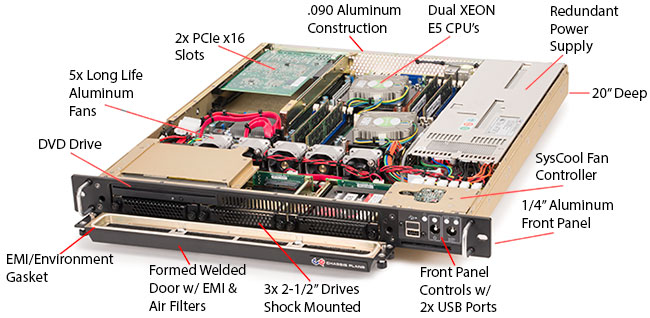High end rugged computer servers are designed to offer excellent performance in environments where conditions such as temperature, humidity, altitude and other disruptive factors would normally render typical computer servers completely useless.
Designed to withstand significant temperature fluctuations and absorb debilitating shocks that would damage conventional systems, a rugged computer server will provide you with all the necessary functional features of a modern high-performance server in incredibly unforgiving environments that would destroy a non-rugged system.
Important Factors To Consider
When buying a rugged computer server, you have to consider many cost and build factors that determine its performance and overall functionality. A server must run continuously while managing problems like overheating and humidity fluctuations without losing any functionality.
The following are the main criteria you’ll want to consider when shopping for a rugged server:
- First, it’s important to assess the technical features of the server. RAM, processing speed, SSD storage capabilities, operating system and security considerations are all important in choosing a server, regardless of whether you need a rugged or a regular machine.
- What is the amount of mechanical shock that the system should be able to withstand? Most industrial grade servers can be deployed on ships’ decks, in trying military conditions, close to volcanoes and in other areas where you can expect it them to be subjected to intense shocks.
- Your server should also be able to deal with the temperature changes in the environment where it will be used. If you need it for applications in extreme climates – such as hot deserts and tropical areas or extremely cold continental environments, you will need to make sure the server’s operating temperature is suitable to the environment in question.
- Humidity is also significant, and perhaps more so for a server than for any other rugged computer system. Servers are often deployed in fixed locations and have to be able to operate continuously when humidity levels suddenly rise or drop.
- Finally, if your server has to operate at high altitudes – such as on planes or in mountainous regions – the design has to be suited to the thin air and other high-altitude challenges as well.
When shopping for a rugged computer, take extra care when examining its operating vs. non-operating specifications. The operating figures are the ones you should be looking at since they determine how the server will behave while working at peak efficiency. The non-operating specs may also be important if you plan on transporting your server from one location to another on a frequent basis.
The Profile of a High Performance Rugged Computer Server

A typical high performance rugged server will be able to withstand altitudes of over 5,000 meters, temperature levels of -30 C to 50 C, humidity levels of up to 95% and shocks of 5-20G – depending on the amount of time they are exposed to the vibrations.
While these figures are general, you can expect most industrial systems to operate within these parameters. A higher price will obviously yield better results, and with custom computer servers you can also adapt the system to the specific temperature, climate and humidity conditions that you will need to deal with in most cases.
About the Author: Stephen Ball is the author of this guest post.


